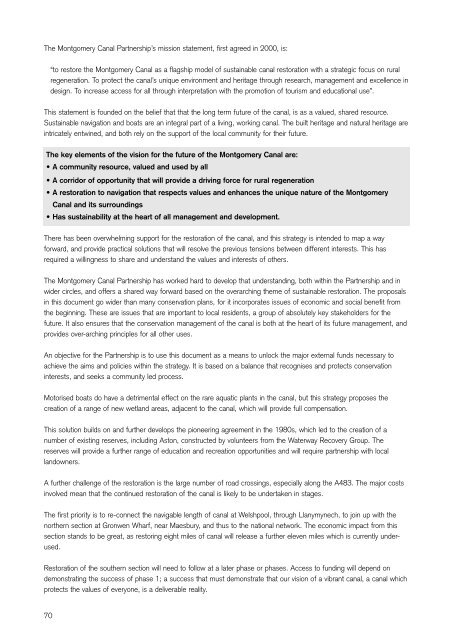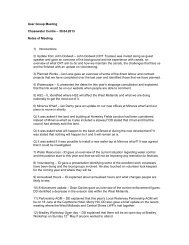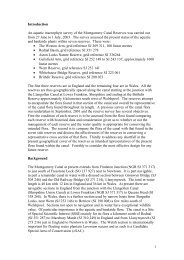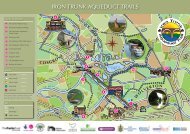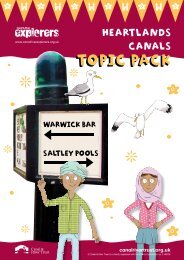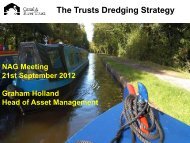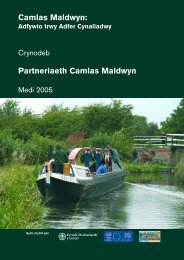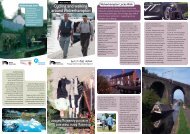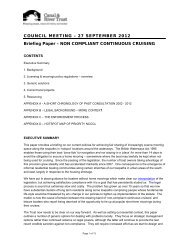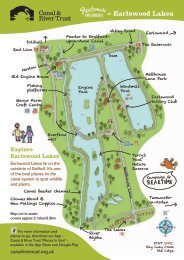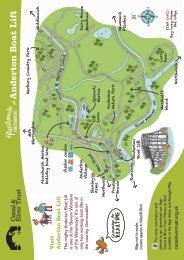Montgomery Canal Conservation Management Strategy (1.2MB PDF)
Montgomery Canal Conservation Management Strategy (1.2MB PDF)
Montgomery Canal Conservation Management Strategy (1.2MB PDF)
Create successful ePaper yourself
Turn your PDF publications into a flip-book with our unique Google optimized e-Paper software.
The <strong>Montgomery</strong> <strong>Canal</strong> Partnership’s mission statement, first agreed in 2000, is:<br />
“to restore the <strong>Montgomery</strong> <strong>Canal</strong> as a flagship model of sustainable canal restoration with a strategic focus on rural<br />
regeneration. To protect the canal’s unique environment and heritage through research, management and excellence in<br />
design. To increase access for all through interpretation with the promotion of tourism and educational use”.<br />
This statement is founded on the belief that that the long term future of the canal, is as a valued, shared resource.<br />
Sustainable navigation and boats are an integral part of a living, working canal. The built heritage and natural heritage are<br />
intricately entwined, and both rely on the support of the local community for their future.<br />
The key elements of the vision for the future of the <strong>Montgomery</strong> <strong>Canal</strong> are:<br />
• A community resource, valued and used by all<br />
• A corridor of opportunity that will provide a driving force for rural regeneration<br />
• A restoration to navigation that respects values and enhances the unique nature of the <strong>Montgomery</strong><br />
<strong>Canal</strong> and its surroundings<br />
• Has sustainability at the heart of all management and development.<br />
There has been overwhelming support for the restoration of the canal, and this strategy is intended to map a way<br />
forward, and provide practical solutions that will resolve the previous tensions between different interests. This has<br />
required a willingness to share and understand the values and interests of others.<br />
The <strong>Montgomery</strong> <strong>Canal</strong> Partnership has worked hard to develop that understanding, both within the Partnership and in<br />
wider circles, and offers a shared way forward based on the overarching theme of sustainable restoration. The proposals<br />
in this document go wider than many conservation plans, for it incorporates issues of economic and social benefit from<br />
the beginning. These are issues that are important to local residents, a group of absolutely key stakeholders for the<br />
future. It also ensures that the conservation management of the canal is both at the heart of its future management, and<br />
provides over-arching principles for all other uses.<br />
An objective for the Partnership is to use this document as a means to unlock the major external funds necessary to<br />
achieve the aims and policies within the strategy. It is based on a balance that recognises and protects conservation<br />
interests, and seeks a community led process.<br />
Motorised boats do have a detrimental effect on the rare aquatic plants in the canal, but this strategy proposes the<br />
creation of a range of new wetland areas, adjacent to the canal, which will provide full compensation.<br />
This solution builds on and further develops the pioneering agreement in the 1980s, which led to the creation of a<br />
number of existing reserves, including Aston, constructed by volunteers from the Waterway Recovery Group. The<br />
reserves will provide a further range of education and recreation opportunities and will require partnership with local<br />
landowners.<br />
A further challenge of the restoration is the large number of road crossings, especially along the A483. The major costs<br />
involved mean that the continued restoration of the canal is likely to be undertaken in stages.<br />
The first priority is to re-connect the navigable length of canal at Welshpool, through Llanymynech, to join up with the<br />
northern section at Gronwen Wharf, near Maesbury, and thus to the national network. The economic impact from this<br />
section stands to be great, as restoring eight miles of canal will release a further eleven miles which is currently underused.<br />
Restoration of the southern section will need to follow at a later phase or phases. Access to funding will depend on<br />
demonstrating the success of phase 1; a success that must demonstrate that our vision of a vibrant canal, a canal which<br />
protects the values of everyone, is a deliverable reality.<br />
70


